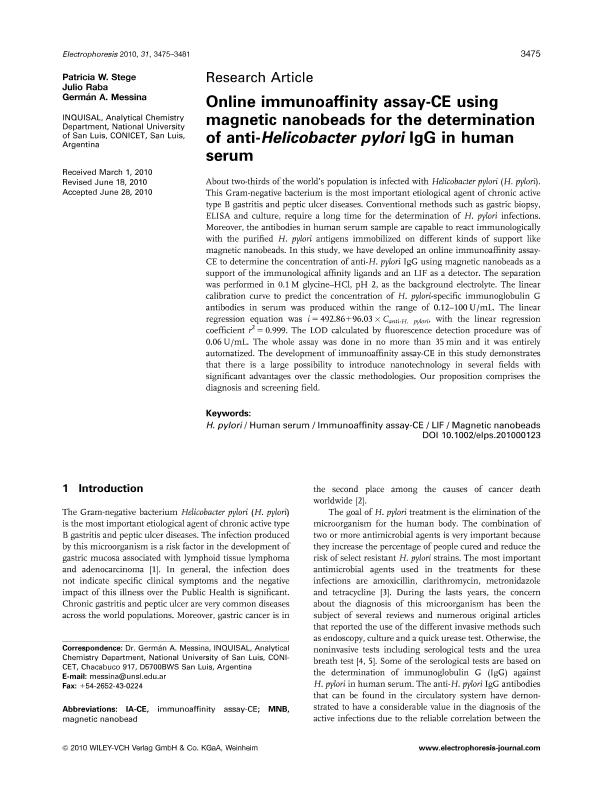Artículo
Online immunoaffinity assay-CE using magnetic nanobeads for the determination of anti-Helicobacter pylori IgG in human serum
Fecha de publicación:
10/2010
Editorial:
Wiley VCH Verlag
Revista:
Electrophoresis
ISSN:
0173-0835
Idioma:
Inglés
Tipo de recurso:
Artículo publicado
Clasificación temática:
Resumen
About two-thirds of the world's population is infected with Helicobacter pylori (H. pylori). This Gram-negative bacterium is the most important etiological agent of chronic active type B gastritis and peptic ulcer diseases. Conventional methods such as gastric biopsy, ELISA and culture, require a long time for the determination of H. pylori infections. Moreover, the antibodies in human serum sample are capable to react immunologically with the purified H. pylori antigens immobilized on different kinds of support like magnetic nanobeads. In this study, we have developed an online immunoaffinity assay-CE to determine the concentration of anti-H. pylori IgG using magnetic nanobeads as a support of the immunological affinity ligands and an LIF as a detector. The separation was performed in 0.1 M glycine-HCl, pH 2, as the background electrolyte. The linear calibration curve to predict the concentration of H. pylori-specific immunoglobulin G antibodies in serum was produced within the range of 0.12-100 U/mL. The linear regression equation was i=492.86+96.03×Canti-H. pylori, with the linear regression coefficient r2=0.999. The LOD calculated by fluorescence detection procedure was of 0.06 U/mL. The whole assay was done in no more than 35 min and it was entirely automatized. The development of immunoaffinity assay-CE in this study demonstrates that there is a large possibility to introduce nanotechnology in several fields with significant advantages over the classic methodologies. Our proposition comprises the diagnosis and screening field.
Palabras clave:
H. PYLORI
,
HUMAN SERUM
,
IMMUNOAFFINITY ASSAY-CE
,
LIF
,
MAGNETIC NANOBEADS
Archivos asociados
Licencia
Identificadores
Colecciones
Articulos(INQUISAL)
Articulos de INST. DE QUIMICA DE SAN LUIS
Articulos de INST. DE QUIMICA DE SAN LUIS
Citación
Stege, Patricia Wanda; Raba, Julio; Messina, Germán Alejandro; Online immunoaffinity assay-CE using magnetic nanobeads for the determination of anti-Helicobacter pylori IgG in human serum; Wiley VCH Verlag; Electrophoresis; 31; 20; 10-2010; 3475-3481
Compartir
Altmétricas




